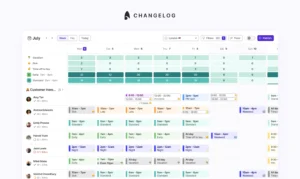
A guide to mastering workforce management KPIs

A quick check-up at the doctor to examine your vitals can uncover health issues and gives you a general indication of your well-being. Likewise, workforce management metrics and KPIs shed light on your workforce’s overall health and performance.
These metrics reveal critical insights into your workforce, like strengths, improvement areas, learning curve, efficiency, and effectiveness. It lets you make data-driven decisions for your workforce’s training, staffing, and scheduling activities, ensuring better customer satisfaction.
So in this post, we’ll dive deeper into workforce management KPIs — their importance, benefits, selection criteria, and nine workforce metrics you can’t ignore.
Why are WFM KPIs important?
The workforce analytics and reporting market is all set to grow at the rate of 11.2% between 2022-2027.
Why? Because workforce tracking enhances a manager’s decision-making efficiency, improves employee productivity, and retains talent.
But there are 4 more reasons👇
- Evaluate employee performance
16% of employers frequently monitor their workforce to track communication and work computer usage. We don’t advise tracking this as it results in intrusive surveillance, lower motivation and higher attrition. Nonetheless, performance monitoring to get a sense of outcomes is important, especially as a success criteria of workforce management. It gives insights into employee productivity and performance and identifies improvement areas.
For example, if your customer service manager measures average handle time (AHT) across team members, it’s important to balance this with the right metrics to avoid just rewarding fast and efficient responses, but also high quality responses. This WFM KPI will also uncover training needs for employees yet to reach the mark.
- Improve and optimise work processes
Tracking KPIs determines if your workforce’s processes are efficient or if there are bottlenecks in the workflow.
For example, if you track First Contact Resolution (FCR), you will know if your employees can solve basic or intermediate-level requests during initial contact. If not, you can transfer the requests between multiple employees or provide additional training to resolve such issues during the first contact.
These KPIs also suggest if you need to optimise workforce scheduling or workload distribution to increase your FCR rates.
- Making informed business decisions
Workforce management involves strategic planning to train employees, allocate resources, schedule activities, and optimise workflows. These decisions need accurate workforce data because it builds a foundation for managers to act upon their choices.
For example, suppose you find out the Total Cost of the Workforce (TCoW) has increased by 10% from the last year. In that case, you may need to rethink allocation, compensation, salaries, overheads, and similar factors increasing the TCoW.
- Facilitate employee growth and development
Tracking workforce KPIs enables you to give your employees tangible targets to achieve specific goals. These targets serve as opportunities to motivate and help them excel in their performance. Moreover, if employees think their existing skill set is insufficient, they’ll look forward to upskilling.
A good workforce management system will allow you to tag skills that employees have and also schedule time for training to help them get the time to upskill.
Suppose you establish the number of successful deliveries and code quality as two crucial KPIs to track a development team’s performance. In that case, the team will put more effort into completing these targets quickly. Thus, it helps them grow in their role, developing new skills to meet the target.
Benefits of keeping a tab on workforce management
With real-time WFM data, you can determine trends and patterns in your workforce’s activities and optimise staffing levels. Plus, your employees can track time-offs and accruals and distribute shifts among themselves while getting accurate compensation.
Other benefits of tracking workforce management are⬇️
1. Enhance customer satisfaction and experience
When you measure and analyse a workforce KPI, you’ll set a target to optimise its value. It encourages your employees to meet that target, improving customer experience with your product/service.
For example, by improving the Average Speed to Answer (ASA), your team can quickly reduce customer wait times and address their needs, boosting customer satisfaction.
2. Optimise staffing levels
You can determine the demand for staff at every point in time by tracking forecasting KPIs. These metrics will consider target response times, production targets, and service level objectives to determine the optimum staff levels at different times.
This way, your workforce won’t be understaffed or overstaffed, and you can meet customer demands on time.
3. Reduce unwanted costs
Tracking your workforce enables aligning staffing levels according to the forecasted demand for different timeframes. It reduces overstaffing or underutilisation of resources. Besides, you can also determine cost per interaction using WFM metrics.
As a result, you’ll have enough data to determine adequate staff, resources, and time for every activity while identifying cost-saving opportunities. Thus, you can cut down on unnecessary costs.
4. Create optimal workforce schedules
Workforce scheduling optimization can help your team effectively work. But it’s possible only when you have workforce metrics that give historical data to determine the staffing levels required to meet customer demands on different occasions. It ensures addressing customer inquiries within target response times and prevents overstaffing during slower periods.
5. Maintain staffing accuracy without forecasts
Workforce management tracking allows businesses to adjust workforce schedules during sudden demand changes or unexpected events. However, it is possible when you have access to real-time scheduling metrics.
Look at how Hypervolt (a UK-based designer, manufacturer, and operator of EV charging infrastructure) reduced their missed call percentage by 10% with Surfboard. They used Surfboard’s granular activity scheduling to have the right staff at the right time.
Things to consider when choosing WFM KPIs
Every business is different and needs WFM KPIs to determine operating efficiency. Consider these factors before you choose KPIs for your business.
- Business goals
Workforce management KPIs should align with your business’s strategic goal. If your goal is to improve customer satisfaction, measuring CSAT (customer satisfaction score) or NPS (net promoter score) will help you make informed decisions.
- Industry
Every industry has its specifications for workforce management. Therefore, KPIs should be specific to industry needs and challenges. For example, call centre workforce management metrics differ from those in a healthcare centre—healthcare centres measure patient wait time while call centres focus mainly on first contact resolution.
- Data availability and measurability
Select KPIs for which you have data readily available for analysis. Plus, the KPIs should be accurately measurable. For example, if you want to maximise employee productivity, an ideal KPI would be average output per hour, which measures the number of units produced over time.
- Actionability
Your WFM KPIs should give you actionable insights. If not, those KPIs won’t bring any change to your operations. Metrics like first contact resolution, occupancy rate, and average handling time are actionable. You can optimise it with training, better scheduling, and enhancements in the knowledge base.
8 must-track WFM metrics
KPIs are often reserved for individual businesses/industries, but high-level KPIs can be measured across all businesses/industries.
- Forecast accuracy
The extent to which demand forecasts match with actual requirements of a workforce is forecast accuracy. It determines if your forecasting methods are effective and are not leading to:
- underutilisation of resources
- understaffing, and
- overstaffing
Forecast accuracy is a vital workforce planning metric because it helps you align your staff with anticipated demand and plan employee shifts accordingly.
- Schedule adherence
It determines how compliant employees are with their assigned schedules. Meaning how many times they adhere to their shifts and the number of times they are absent.
Schedule adherence helps managers track an employee’s time spent on scheduled tasks and absenteeism while ensuring the workforce is available for the customers as planned.
One way to maintain high schedule adherence is to conduct counselling sessions to understand the reasons behind absenteeism. These sessions may uncover reasons like overwhelming schedules or lack of incentives which you can adjust accordingly.
- SLA compliance
SLA (Service Level Agreement) compliance determines the number of customer service targets met successfully. These targets could include response times, resolution, reopen rates, etc. If the performance in meeting these targets matches the agreed level of service, it indicates higher customer satisfaction.
If SLAs are violated, the managers can rectify this issue by optimising resource allocation, recreating staff schedules, and training them for better resolution.
- Average handle time
An employee’s average time to handle one customer interaction is average handle time (AHT). These interactions could be by phone, email, chat, or support tickets. Identifying this time helps managers to understand the complexity of issues, adherence to training programs, and workflow efficiency.
If the time taken exceeds the specified thresholds, you can take necessary actions to increase the interactions per unit of time. For example, targeted training programs can help employees deal with more specific issues and reduce knowledge gaps.
- First contact resolution
Statistics reveal that 83% of customers expect the support agent to solve their issue during their first contact.
And that’s where this metric comes in.
FCR determines the percentage of issues resolved when the customer interacts with the employee for the first time.
Tracking FCR also uncovers the reasons behind multiple interactions for resolution.
A high FCR reduces workload, customer frustration, and escalations, boosting employee and customer experience. To maintain it, you can improve your documentation or increase self-service options.
- Occupancy rate
Occupancy rate determines the time spent handling productive tasks such as customer interaction and issue resolution. It is later compared to non-productive functions like training and breaks to calculate the occupancy rate.
One way to improve the occupancy rate is activity scheduling using Surfboard.
Also known as intraday scheduling, this feature allows you to plan your employees’ activities when they’re on shift while ensuring their sanity.
Here’s how you can implement activity scheduling seamlessly by using Surfboard:
- Share your plans
Surfboard asks for your priorities, scheduling rules, and coverage time for each channel and schedules your workforce automatically. It ensures the workload gets distributed evenly among the surfers and they have enough time for breaks. They can even engage in training during slower periods.
- Decide coverage rules
You can feed your coverage rules, especially for live channels. It ensures the right number of people are present at the right time.
Surfboard uses these rules to create activity plans for your team, giving you the flexibility to adjust the coverage. You can monitor your staff’s occupancy every 30 minutes.
- Pick time zones and languages
Surfboard schedules activities based on time zones, language, and skill required for each activity. You can also check country-wise schedules and monitor the occupancy without any hassle.
- Employee satisfaction
Employee satisfaction monitors the extent to which your employees are satisfied with their jobs, salaries, and workload.
It also determines if they are willing or forced to do their job. High employee satisfaction rates indicate the existence of a positive work environment, which in turn, boosts productivity and employee retention rates.
Businesses can collect employee feedback to evaluate employee satisfaction. Implement initiatives to make employees feel valued if the satisfaction rate is low.
- Attrition rate
The attrition rate determines the percentage of staff resigning from the organisation over a particular duration. These resignations could be due to a hostile environment, overwhelming work schedules, lack of work-life balance, or lack of personal growth and development.
Understanding the reasons behind a high attrition rate can help you devise workforce retention strategies like introducing new learning opportunities or optimising workforce scheduling to increase surfer satisfaction.
Bonus: The top 5 call centre workforce management metrics you can’t ignore
Here are the five most important WFM KPIs to track:
1 – Shrinkage
Shrinkage refers to the time call centre agents are being paid but are unavailable to take calls. This time could include training sessions, manager meetings, or switching shifts with other agents.
2 – Contact abandonment rate
It refers to the percentage of customers calling a contact centre and hanging up before speaking to an agent. The change of mind could be due to high AHT or unavailability of staff during peak times.
3 – Absenteeism
Absenteeism is the percentage of call centre agents leaving their workstations without approved leaves or for unauthorised time. When agents leave the workstation uninformed during their scheduled shift, they are considered absent.
4 – Advisor (surfer) proficiency
It refers to the extent of expertise and competence a call centre agent has to resolve customer queries. It is measured individually and considered necessary while scheduling the staff during peak times.
5 – Utilisation
Unlike occupancy rate, utilisation refers to when agents log in to their systems, resolve customer issues, and expect customer interactions. It accounts for the time agents work within the paid period.
Optimise your workforce management KPIs with Surfboard
No matter your business, measuring WFM KPIs helps improve your workforce performance and make customers happy.
Surfboard makes this possible with its workforce scheduling capabilities.
From planning your workforce’s shifts to creating accurate schedules based on forecasts, Surfboard ensures having sufficient surfers for the right tasks at the right time.
Book a demo today to understand how our scheduling features can help your business case.
FAQs
What are the KPIs in WFM?
KPIs in WFM are metrics that measure and evaluate the overall performance of a workforce, keeping in mind factors like customer satisfaction and experience, employee productivity, workforce efficiency, and quality of service.
What are the 3 types of KPIs?
The 3 types of KPIs common in WFM are:
- Outcome-based KPIs:
These KPIs measure the outcome of a task, process, or workflow—for example, CSAT score and employee retention rates.
- Process-based KPIs:
These KPIs measure a process’s performance to determine its efficiency and validity for tasks under concern—for example, average response time and mean time to resolve.
- Driver-based KPIs:
These KPIs measure the factors that produce specific outcomes or carry out processes. For example, first contact resolution and customer retention rate.
How do you measure KPI?
You can measure KPIs by collecting data points, creating benchmarks, comparing them with the collected data, and then analysing the results.
A specific WFM formula calculates the KPI’s numeric value, which you can use to compare and analyse the results.
WFM formula – The ratio of an agent’s total paid time to the time spent answering calls (talk time plus wrap-up time). It can be done by dividing the gross workforce by the net workload.
What are the 4 performance measures?
The 4 performance measures actively used in workforce management include employee productivity, customer satisfaction, service quality, and process efficiency.
What is the role of RTA in WFM?
RTA (Real-Time Adherence) in WFM is a workforce KPI that measures the real-time availability of surfers during shifts. It helps managers ensure surfers are available in the right place and time. Managers can swiftly appoint substitute surfers and continue operations if there are deviations in the assigned schedules.



